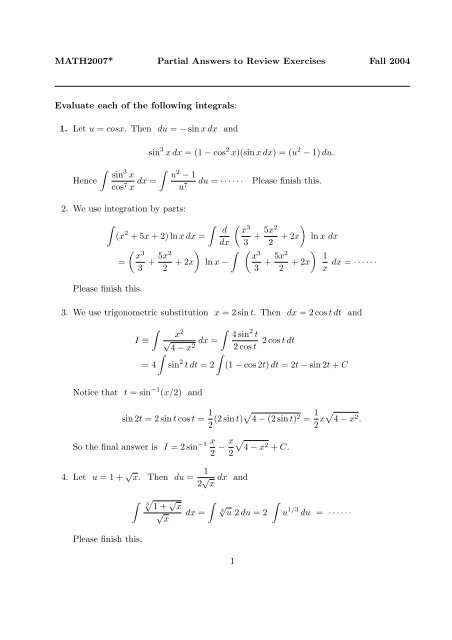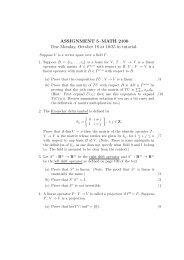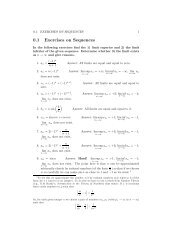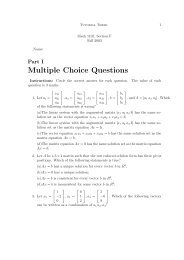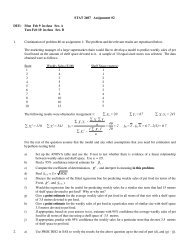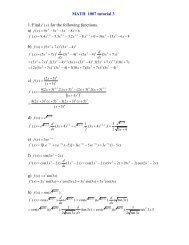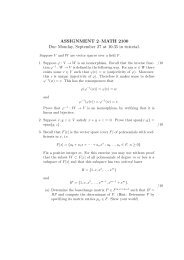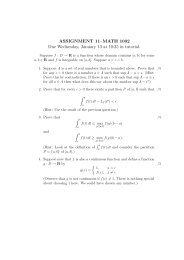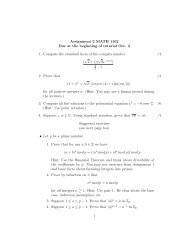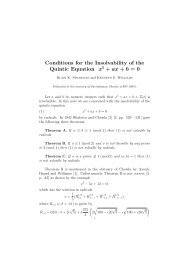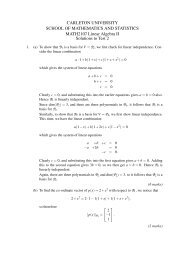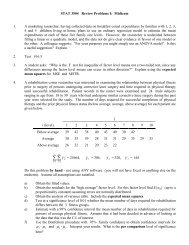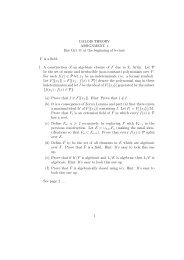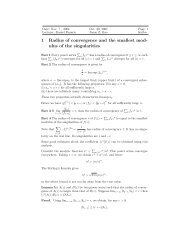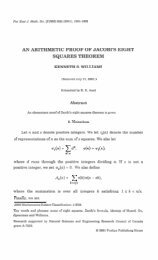1. Let u = cosx. Then du = s
1. Let u = cosx. Then du = s
1. Let u = cosx. Then du = s
Create successful ePaper yourself
Turn your PDF publications into a flip-book with our unique Google optimized e-Paper software.
MATH2007* Partial Answers to Review Exercises Fall 2004<br />
Evaluate each of the following integrals:<br />
<strong>1.</strong> <strong>Let</strong> u = <strong>cosx</strong>. <strong>Then</strong> <strong>du</strong> = − sin x dx and<br />
Hence<br />
sin 3 x dx = (1 − cos 2 x)(sin x dx) = (u 2 − 1) <strong>du</strong>.<br />
3<br />
sin x<br />
cos7 2 u − 1<br />
dx =<br />
x u7 <strong>du</strong> = · · · · · · Please finish this.<br />
2. We use integration by parts:<br />
<br />
Please finish this.<br />
(x 2 3 d x 5x2<br />
+ 5x + 2) ln x dx =<br />
+<br />
dx 3 2<br />
<br />
3<br />
3<br />
x 5x2<br />
x 5x2<br />
= + + 2x ln x − +<br />
3 2 3 2<br />
<br />
+ 2x<br />
ln x dx<br />
<br />
1<br />
+ 2x<br />
x<br />
dx = · · · · · ·<br />
3. We use trigonometric substitution x = 2 sin t. <strong>Then</strong> dx = 2 cos t dt and<br />
<br />
x<br />
I ≡<br />
2 2<br />
4 sin t<br />
√ dx = 2 cos t dt<br />
4 − x2 2 cos t<br />
<br />
= 4 sin 2 <br />
t dt = 2 (1 − cos 2t) dt = 2t − sin 2t + C<br />
Notice that t = sin −1 (x/2) and<br />
sin 2t = 2 sin t cos t = 1<br />
2 (2 sin t) 4 − (2 sin t) 2 = 1<br />
2 x 4 − x 2 .<br />
−1 x<br />
So the final answer is I = 2 sin<br />
2<br />
4. <strong>Let</strong> u = 1 + √ x. <strong>Then</strong> <strong>du</strong> = 1<br />
2 √ dx and<br />
x<br />
Please finish this.<br />
3 1 + √ x<br />
√ x<br />
x<br />
− 4 − x2 + C.<br />
2<br />
<br />
√3 dx = u 2 <strong>du</strong> = 2<br />
1<br />
u 1/3 <strong>du</strong> = · · · · · ·
5. Use the partial fractions decomposition<br />
Please finish this.<br />
1<br />
x 2 + 2x − 15 =<br />
1<br />
(x − 3)(x + 5)<br />
<br />
1 1 1<br />
= − .<br />
8 x − 3 x + 5<br />
6. Use the trigonometric substitution x = (3/2) tan t. Please continue and finish this.<br />
7. Use the partial fractions decomposition of the form<br />
1<br />
4x 3 + x =<br />
Please continue and finish this.<br />
1<br />
x(4x 2 + 1)<br />
= A<br />
x<br />
+ Bx + C<br />
4x 2 + 1 .<br />
8. Use the trigonometric substitution x = cos t. Please continue and finish this.<br />
9. Note that x 4 − x = x(x 3 − 1) = x(x − 1)(x 2 + x + 1). Use the partial fractions<br />
decomposition of the form<br />
2x 3 − x 2 − 2x − 2<br />
x 4 − x<br />
Please continue and finish this.<br />
= A<br />
x<br />
B Cx + D<br />
+ +<br />
x − 1 x2 + x + 1 .<br />
Determine which of the following improper integrals converge:<br />
<strong>1.</strong><br />
2.<br />
3.<br />
4.<br />
5.<br />
1<br />
−1<br />
−1<br />
−∞<br />
∞<br />
e<br />
∞<br />
−∞<br />
1<br />
0<br />
dx<br />
. Divergent.<br />
(x + 1) 3/2<br />
dx<br />
. Convergent.<br />
1 + x2 dx<br />
. Divergent.<br />
x ln x<br />
xe −x2<br />
dx. Convergent.<br />
dx<br />
x √ . Divergent. 6.<br />
x<br />
π/2<br />
sec x dx. Divergent.<br />
0<br />
2
Sketch the curves described by parametric or polar equations and write down<br />
the integrals representing their lengths (do not evaluate these integrals):<br />
<strong>1.</strong> We have dx/dt = e t , dy/dt = −2e −2t . So the arc length is<br />
1<br />
−1<br />
(dx/dt) 2 + (dy/dt) 2 dt =<br />
1<br />
2. dx/dt = 6 cos 3t, dy/dt = −6 sin 3t. So the arc length is<br />
π/2<br />
0<br />
−1<br />
<br />
6 2 cos 2 3t + 6 2 sin 2 3t dt<br />
e 2t + 4e −4t dt.<br />
4. We have x = r cos θ = cos 3θ cos θ and y = r sin θ = cos 3θ sin θ. So<br />
dx/dθ = −3 sin 3θ cos θ − cos 3θ sin θ, dy/dθ = −3 sin 3θ sin θ + cos 3θ cos θ<br />
So the required arc length is<br />
L =<br />
=<br />
2π<br />
0<br />
2π<br />
0<br />
The required area is 1<br />
<br />
2 C<br />
(−3 sin 3θ cos θ − cos 3θ sin θ) 2 + (−3 sin 3θ sin θ + cos 3θ cos θ) 2 dt<br />
<br />
9 sin 2 3θ + sin 2 2π <br />
3θ dθ = 1 + 8 sin<br />
0<br />
2 3θ dθ.<br />
r 2 dθ = 1<br />
π/6<br />
2 −π/6<br />
Solve each of the following differential equations:<br />
<strong>1.</strong> Separate variables and integrate:<br />
<br />
e −y <br />
dy =<br />
2. Using the integratiing factor ex2, we have<br />
d<br />
dx (ex2y)<br />
= (x + 1)e x2 +2x<br />
cos 2 3θ dθ. Please compute this integral.<br />
or e x2<br />
y =<br />
<strong>Let</strong> u = (x + 1) 2 ≡ x 2 + 2x + <strong>1.</strong> The last integral becomes<br />
Please finish this.<br />
1<br />
2<br />
<br />
sin x dx. Please finish it.<br />
<br />
e u−1 <strong>du</strong> = 1<br />
2 eu−1 + C.<br />
3<br />
(x + 1)e x2 +2x dx.
3. This is a homogeneous equation. As usual, let u = y/x. <strong>Then</strong> y = xu, which gives<br />
dy/dx = u + x(<strong>du</strong>/dx). The original equation becomes<br />
u + x <strong>du</strong> 1 + u 1<br />
= =<br />
dx u + u2 u<br />
or x <strong>du</strong> 1 − u2<br />
= .<br />
dx u<br />
Separating variables, we have<br />
<br />
u <strong>du</strong> dx<br />
= . Please finish.<br />
1 − u2 x<br />
4. Answer: y = C1e (−2+√ 7)x + C2e (−2−√ 7)x . Notice that r = −2 ± √ 7 are roots of<br />
r 2 + 4r − 3 = 0.<br />
5. Answer: y = −x + C1e x + C2e −x .<br />
6. Write M = e x sin y + 2x and N = e x cos y + 2y. We can check<br />
∂M/∂y = ∂N/∂x = e x cos y.<br />
Hence this equation is exact. We look for a function u = u(x, y) satisfying<br />
∂u<br />
∂x = M ≡ ex sin y + 2x,<br />
From the first equation we have<br />
<br />
u =<br />
∂u<br />
∂y = N ≡ ex cos y + 2y.<br />
(e x sin y + 2x) dx = e x sin y + 2x 2 + h(y).<br />
Substitutuing this in the second equation, we obtain h ′ (y) = 2y, from which we get<br />
h = y 2 + C0. So the final answer (in the form u = C) is e x sin y + 2x 2 + y 2 = C.<br />
7. The general solution to the homogeneous equation y ′′ + y ′ − 2y = 0 is yH =<br />
C1e −2x + C2e x . The final answer is of the form y = yH + yS. To find a special<br />
solution yS, try yS = A cos(2x) + B sin(2x). Please complete these steps.<br />
8. The final answer is y = yH + yS, where yH is the same as the one in Question 7<br />
above. To find a particulra solution yS, try yS = Ae −x . Please complete this.<br />
9. The final answer is y = yH + yS. where yH is the same as the one in Question 7<br />
above. To find a particulra solution yS, try yS = Ae 3x . Please complete this.<br />
Determine whether the given sequence is convergent or divergent:<br />
<strong>1.</strong><br />
(−1) n e n<br />
n 2<br />
<br />
. The sequence diverges to infinity.<br />
4
2.<br />
3.<br />
n 2n<br />
. The sequence diverges to infinity in view of<br />
1 + n<br />
2 n<br />
n n<br />
<br />
. The sequence converges to zero.<br />
2n<br />
1 + n<br />
→ 2 as n → ∞.<br />
Determine whether the given series is conditionally convergent, absolutely convergent,<br />
or divergent:<br />
<strong>1.</strong> ∞<br />
n=1<br />
2. ∞<br />
n=1<br />
3. ∞<br />
n=1<br />
1 ∞<br />
≤<br />
nen n=1<br />
4n − 1<br />
n 3<br />
1<br />
e n<br />
≤ ∞<br />
n=1<br />
n + 2n ∞<br />
≤<br />
1 + 3n n=1<br />
<br />
= 1<br />
<br />
e − 1<br />
4n ∞<br />
= 4<br />
n3 n=1<br />
2 n + 2 n<br />
3 n<br />
4. The series converges. Actually, ∞<br />
5. This series is absolutely convergent.<br />
6. Notice that<br />
<br />
n n n + 1<br />
=<br />
2n + 1<br />
n + 1<br />
< ∞. So the series converges.<br />
1<br />
< ∞. So the series converges.<br />
n2 (= 4) < ∞. So the series converges.<br />
n=1<br />
3 2n+1<br />
n!<br />
2n + 1<br />
= 3 ∞<br />
→ 1<br />
2<br />
n=0<br />
9 n<br />
n! = 3e9 .<br />
as n → ∞.<br />
Since 1/2 < 1, the root test tells us the convergence of the given series.<br />
7. Note that cos nπ is nothing but (−1) n . So<br />
∞<br />
n=1<br />
n cos nπ ∞<br />
=<br />
1 + n2 n=1 (−1)n n<br />
1 + n2 which is convergent in view of the alternating series test. This series is not absolutely<br />
convergent. Indeed<br />
∞ n<br />
= ∞.<br />
n=1 1 + n2 8. Note that<br />
<br />
n<br />
n2n (1 + 2n2 =<br />
) n n2<br />
Hence the series is convergent.<br />
1<br />
→<br />
1 + 2n2 2<br />
5<br />
as n → ∞.
9. Notice that, for large n,<br />
So<br />
∞<br />
n=1<br />
sin π<br />
n<br />
≈ π<br />
n<br />
<br />
sin x<br />
because lim<br />
x→0 x<br />
sin π<br />
, comparable to the divergent series<br />
n<br />
10. Use the integral test and compute<br />
∞<br />
1<strong>1.</strong> The series is conditionally convergent.<br />
2<br />
dx<br />
x ln x<br />
12. Since n/ ln n → ∞ as n → ∞, the series diverges.<br />
∞<br />
n=1<br />
= 1<br />
<br />
.<br />
1<br />
, diverges as well.<br />
n<br />
= · · · = ∞. The series diverges.<br />
In each part, find all x for which the given series is convergent:<br />
<strong>1.</strong><br />
2.<br />
3.<br />
4.<br />
5.<br />
∞ (x − 1) n<br />
n=1<br />
∞<br />
n=1<br />
∞<br />
n=1<br />
n!<br />
n 3 (x − 5) n<br />
x n<br />
5 n n 5<br />
∞ (4x + 1) n<br />
n=1<br />
∞<br />
n=1<br />
n 2<br />
n(x − 4) n<br />
2n 2 + 3<br />
Answer: (−∞, ∞)<br />
Answer: (4, 6)<br />
Answer: [−5, 5].<br />
Answer: [−1/2, 0].<br />
Answer: [−3, 5).<br />
Find the Taylor series of f(x) at x = a and its interval of convergence:<br />
<strong>Let</strong>’s recall a list of well-known series expansions that one should learn by heart:<br />
1<br />
1 − x =<br />
∞<br />
x n<br />
n=0<br />
ln<br />
1<br />
1 − x =<br />
6<br />
∞<br />
n=1<br />
x n<br />
n<br />
e x =<br />
∞<br />
n=0<br />
x n<br />
n!
sin x =<br />
∞<br />
(−1)<br />
n=0<br />
n x2n+1<br />
(2n + 1)!<br />
cos x =<br />
If possible, we make use of any one of these identities.<br />
∞<br />
(−1)<br />
n=0<br />
n x2n<br />
(2n)! .<br />
<strong>1.</strong> In the following manipulation, keep in mind that we are trying to use the second<br />
identity above<br />
ln x = ln(3 − (3 − x)) = ln 3(1 − (1 − x/3)) = ln 3 + ln(1 − (1 − x/3))<br />
= ln 3 − ∞<br />
n=1<br />
(1 − x/3) n<br />
(Note that 1 − x/3 = ((−1)/3) (x − 3).)<br />
2. With a = −1, we have<br />
e 2x+3 = e 2(x+1)+1 = e e 2(x+1) = e ∞<br />
3. Again we try to ue the second identity<br />
4. At x = π/3, we have<br />
5. This is easy:<br />
n<br />
= ln 3 − ∞<br />
n=0<br />
n=1<br />
2 n (x + 1) n<br />
ln(2 + x 2 ) = ln 2(1 − (−x 2 /2)) = ln 2 − ln<br />
= ln 2 − ∞<br />
n=0<br />
n=1<br />
(−x/2) n<br />
n<br />
n!<br />
= ln 2 − ∞<br />
(−1) n<br />
3 n n (x − 3)n .<br />
= e ∞<br />
n=0<br />
1<br />
1 − (−x/2)<br />
n=1<br />
(−1) n<br />
2 n n xn .<br />
2 n<br />
n! (x + 1)n .<br />
<br />
π<br />
sin x = sin<br />
3 +<br />
<br />
x − π<br />
<br />
= sin<br />
3<br />
π<br />
3 cos<br />
<br />
x − π<br />
<br />
+ cos<br />
3<br />
π<br />
3 sin<br />
<br />
x − π<br />
<br />
3<br />
√ ∞ 3 (−1)<br />
=<br />
2<br />
n <br />
x −<br />
(2n)!<br />
π<br />
2n + =<br />
3<br />
1<br />
∞ (−1)<br />
2<br />
n <br />
x −<br />
(2n + 1)!<br />
π<br />
2n+1 .<br />
3<br />
xe x = x ∞<br />
n=0<br />
6. We use the double angle formula<br />
x n<br />
n! =<br />
∞<br />
n=0<br />
sin x cos x = 1 1 ∞<br />
sin(2x) =<br />
2 2 n=0<br />
= 1 ∞<br />
2 n=0<br />
n=0<br />
x n+1<br />
n! =<br />
∞<br />
n=1<br />
(−1) n (2x) 2n+1<br />
(2n + 1)!<br />
(−1) n 2 2n+1<br />
(2n + 1)! x2n+1 = ∞<br />
7<br />
n=0<br />
x n<br />
(n − 1)! .<br />
(−1) n 2 2n<br />
(2n + 1)! x2n+1 .
Find the binomial series of the given function<br />
We use the binomial expansion formula (1 + x) α = ∞<br />
<strong>1.</strong><br />
1<br />
(1 − x) 3 = (1 + (−x))−3 = ∞<br />
So we have<br />
<br />
−3<br />
=<br />
n<br />
(−3)(−3 − 1)(−3 − 2) · · · (−3 − n + 1)<br />
n=0<br />
n=0<br />
<br />
−3<br />
(−x)<br />
n<br />
n with<br />
n!<br />
n 3 × 4 × 5 × · · · × (n + 2)<br />
= (−1)<br />
1 × 2 × 3 × · · · × n<br />
1<br />
= (1 + (−x))−3<br />
(1 − x) 3<br />
∞<br />
n (n + 1)(n + 2)<br />
= x (−1) (−x)<br />
2<br />
n =<br />
n=0<br />
2. x √ 1 − x = x(1 + (−x)) 1/2 = x ∞<br />
<br />
1/2<br />
(−1)<br />
n<br />
n =<br />
n=1<br />
1/2<br />
n<br />
<br />
α<br />
x<br />
n<br />
n to each part:<br />
n (n + 1)(n + 2)<br />
= (−1)<br />
1 × 2<br />
∞<br />
n=0<br />
<br />
(−1) n x n . For n ≥ 1,<br />
1/2(1/2 − 1)(1/2 − 2) · · · (1/2 − n + 1)<br />
(−1)<br />
n!<br />
n<br />
= (−1)n−1<br />
2 n<br />
(n + 1)(n + 2)<br />
x<br />
2<br />
n+1 .<br />
1 × 3 × 5 × · · · × 2n − 1<br />
(−1)<br />
n!<br />
n (2n − 1)!!<br />
= −<br />
2n .<br />
n!<br />
8


